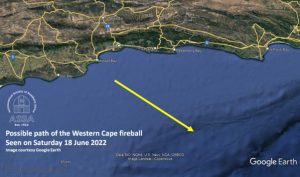23 June 2022
Several hundred tonnes of solid particles enter Earth’s atmosphere every day. Most of these are small particles left behind by comets as they round the Sun. Particles travelling through space are called meteoroids. Particles entering the atmosphere at high speed, typically 20-70 km/sec, become visible as meteors (or popularly as ‘shooting stars’) and burn up before they reach the ground. Very bright meteors are called fireballs, and those that are seen to explode are called bolides. If the object survives its passage through the atmosphere and reaches the ground it is called a meteorite. These objects are much larger than ordinary meteors and are due to entry of fragments of asteroids into the atmosphere.
During the early morning of Saturday 18 June, a small fragment of asteroid entered the atmosphere resulting in a very bright bolide, which was widely seen over the Western Cape’s Garden Route region. This is the fourth very bright fireball seen over the Western Cape in recent years.
Time and duration
Most reports gave the time as 05h47 SAST. One observer confirmed this time from a GPS, so it can be considered as correct. Some videos were posted online which showed time stamps with a different time, but these time stamps are taken from PCs which were uncalibrated and therefore unreliable. Many gave the duration of the passage of the fireball as three to four seconds, but again the attention of most people was only drawn to the presence of the fireball by the very bright flash, at which point the object disrupted. There were probably few sightings of the object when it began its fiery path in the upper atmosphere at about 120 km altitude.
Brightness and colour
The brightness of very bright fireballs is always subjective, as there are few bright objects with which to compare. Most comparisons are made against the sun, or full Moon, neither of which was visible at the time, thought the 82% illuminated Moon was high in the north at the time. Estimates of the brightness were between 50-100 times the brightness of the Moon. Various colours were reported and included nearly the entire spectrum from red, orange, yellow, green and blue, and bright white. There were many reports of bright green, which is typical of bright meteors, becoming red as the object descended towards the horizon.
Fragmentation, persistent train and sounds heard
Most agreed that the object exploded during its path, splitting into numerous fragments. One observer said there were four or five large fragments, and another said there were more than 50 smaller fragments. There were no reports of any smoke train left behind after the fireball disappeared. Only two people said they heard sounds, one like a crack, the other three distinct explosions.
Path of the fireball
From various reliable eye witness accounts we reconstructed the path of the fireball as shown by the yellow arrow. The fireball was first seen just south and perhaps west of Mossel Bay. The yellow arrow may have started further to the west, but was only really noticed around the time of the bright flash, by which time it was south of the coast. The fireball burned out and entered ‘dark flight’ at which stage it had been slowed down to the extent that it no longer caused visible light, around 120 km to the south, and perhaps slightly east of Plettenberg Bay.
Conclusion
A small fragment of asteroid entered the atmosphere on Saturday 18 June at 05h47 SAST, resulting in a bright fireball visible to the south of the Garden Route. The object disrupted in a bright flash, leaving several fragments which continued and burned out to the south of Plettenberg Bay.

